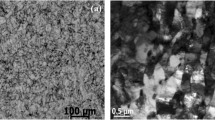Abstract
High strength low alloy (HSLA) steels are a relatively new group of alloys having higher strength as a result of composition and processing variations. Because these HSLA steels are being widely used in applications susceptible to a few cycles of stress or strain in the plastic region, the low cycle fatigue (LCF) properties of these steels are very important to design engineers; and as a result, a knowledge of the extent of the effects of several steel variables (viz, thickness, composition, processing variables, and so forth) and cold-work on the LCF properties of a single steel grade is very desirable from design safety considerations. Specimens obtained from a commercial grade of hot-rolled, pickled and oiled Nb-bearing, fine grained HSLA steel covering three thicknesses, two heats and four coil-positions were characterized as regards to their monotonie and cyclic properties. The present study indicates that the LCF behavior of this commerical grade steel is very insensitive to “steel variables” such as composition, thickness and coil-position. The large increase in monotonie strength obtained by cold-work is not retained under cyclic loading and the LCF behavior of cold-worked samples approached that of undeformed material.
Similar content being viewed by others
References
R. W. Landgraf: ASTM STP 467, p. 3, ASTM, Philadelphia, 1970.
C. E. Feltner and P. Beardmore: ibid, p. 77.
C. E. Feltner and R. W. Landgraf:J. Basic Eng., 1971, vol. 93, p. 441.
E. Dowling:J. Mater., 1972, vol. 7, p. 71.
E. R. Morgan, T. E. Dancy, and M. Korchynsky:Metal Progr., 1966, vol. 89, p. 125.
M. Korchynsky and H. Stuart:Symposium Low Alloy High Strength Steel, p. 17, The Metallurg Companies, New York, 1970.
L. Luyckx, J. R. Bell, A. McLean, and M. Korchynsky:Met. Trans., 1970, vol. 1, p. 3341.
J. M. Gray:Cold-Rolled High Strength Steels for Automotive Applications, SAE paper No. 730527, Society of Automotive Engineers, Inc., Warrendale, PA, 1973.
J. M. Gray:Processing and Properties of Low Carbon Steel, J. M. Gray, ed., p. 225, TMS-AIME, New York, 1973.
L. Meyer, F. Heisterkamp, and D. Lautenborn: p. 297.
J. A. Vaccari:Mater. Eng., 1974, vol. 79, p. 24.
R. P. Morgan, R. A. Bosch, and P. B. Lake:Steel in the Automotive Industry-Challenge and Response, AISI 84th General Meeting, New York, American Iron and Steel Institute, Washington, D.C., 1976.
M. E. Fine and S. Ikeda:Fatigue in High Strength Steel, AISI Project No. 64-303, American Iron and Steel Institute, Washington, 1975.
P. Watson and T. H. Topper:An Evaluation of the Fatigue Performance of Automotive Steels, SAE paper No. 710597, Society of Automotive Engineers, Inc., Warrendale,PA, 1971.
L. E. Tucker, R. W. Landgraf, and W. R. Brose:Proposed Technical Report on Fatigue Properties for the SAE Handbook, SAE paper No. 740279, Society of Automotive Engineers, Inc., Warrendale, PA, 1974.
L. E. Tucker, S. Downing, and Louis Camillo:Accuracy of Simplified Fatigue Prediction Methods, SAE paper No. 750043, Society of Automotive Engineers, Inc., Warrendale, PA, 1975.
A. M. Sherman:Met. Trans. A, 1975, vol. 6A, p. 1035.
Recommended Practice for Constant Amplitude Low Cycle Fatigue Testing, Sixth Draft, Committee E9.08, American Society for Testing and Materials, Philadelphia, December 1974.
Tentative Recommended Practice for Constant-Amplitude Low Cycle Fatigue Testing, ASTM E606-77T, Annual Book of ASTM Standards, Part 10, American Society for Testing and Materials, Philadelphia, 1977.
Fatigue Testing of High Strength Low Alloy Steels, Ford Motor Company Laboratory Test Method BA-9-3, Ford Motor Company, Dearborn, Michigan, 1976.
Manual on Low Cycle Fatigue Testing, STP 465, American Society for Testing and Materials, Philadelphia, 1969.
Standard Methods of Tension Testing of Metallic Materials, ANSI/ASTM E8, Annual Book of ASTM Standards, Part 10, American Society for Testing and Materials, Philadelphia, 1977.
R. W. Landgraf, J. D. Morrow, and T. Endo:J. Mater., 1969, vol. 4, p. 176.
R. W. Landgraf, M. R. Mitchell, and N. R. LaPointe:Monotonie and Cyclic Properties of Engineering Materials, Metallurgical Dept., Scientific Research Staff, Ford Motor Company, Dearborn, Michigan, June 1972.
R. W. Landgraf, A. M. Sherman, and J. W. Sprys:Fatigue Behavior of Low Carbon Steels as Influenced by Microstructures, Proceedings of the Second International Conference on Mechanical Behavior of Materials, p. 513, ASM, Metals Park, OH, 1976.
D. J. Quensel and M. Meshii: Investigation of Cyclic Deformation and Fatigue Failure in High Strength Low Alloy Steels, ibid, p. 764.
D. Aichbhaumik: unpublished work, National Steel Research Center, Weirton, WV, 1976.
A Guide for Fatigue Testing and the Statistical Analysis of Fatigue Data, Supplement to Manual on Fatigue Testing, STP-91 A, American Society for Testing and Materials, Philadelphia, 1963.
R. E. Little:Statistical Planning and Analysis, STP-588, American Society for Testing and Materials, Philadelphia, 1975.
I. Miller and J. F. Freund:Probability and Statistics for Engineers, Prentice-Hall, Englewood Cliffs, 1977.
T. W. Crooker,Mechanical Engineering, vol. 99, p. 40, 1977.
J. D. Morrow:Internal Friction, Damping and Cyclic Plasticity, STP-378, p. 45, American Society for Testing and Materials, Philadelphia, 1965.
Author information
Authors and Affiliations
Rights and permissions
About this article
Cite this article
Aichbhaumk, D. Steel variability effects on low cycle fatigue behavior of a single grade of high strength low alloy steel. Metall Trans A 10, 269–278 (1979). https://doi.org/10.1007/BF02658334
Received:
Issue Date:
DOI: https://doi.org/10.1007/BF02658334




